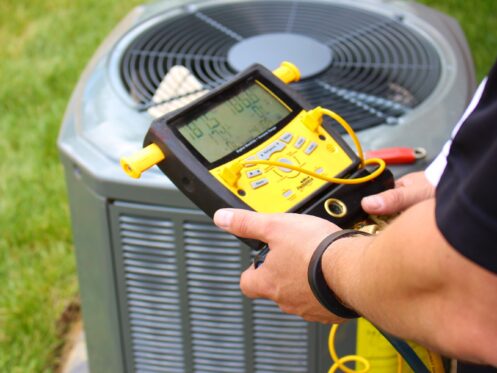Your HVAC system works hard to keep your home comfortable year-round, but without proper insulation, that effort is often wasted. Insulation plays a major role in helping your system do its job efficiently; however, it’s often overlooked. In this blog, we’ll explore how insulation supports HVAC performance, where to install it, and what signs may indicate your home is under-insulated.
Why Insulation Matters for Efficiency
Insulation acts as a barrier between your home and the outdoors. It slows the transfer of heat, keeping warm air from escaping your living space during the winter. During the summer, it also prevents hot air from entering your home through the roof. Without adequate insulation, your HVAC system works harder to compensate for temperature loss or gain, resulting in higher energy use. It also contributes to the wear and tear of your equipment. Insulation allows your HVAC system to do its job efficiently. When it’s lacking or improperly installed, even a top-of-the-line system will experience performance issues.
How Insulation Works
You measure insulation by its R-value, which indicates its resistance to heat flow. The higher the R-value, the better the material is at insulating your home. Different areas in your home require different types and amounts of insulation. The climate of the area that you live in will also determine the insulation that you need. Each type of material has strengths and ideal applications that you should consider before the installation process.
Common types of insulation include:
- Fiberglass batts
- Blown-in cellulose or fiberglass
- Spray foam
- Rigid foam boards
Areas to Insulate That Provide the Most HVAC Efficiency
When you are adding insulation to your home, there are a few locations that you should consider. Installing insulation in these locations will enhance the efficiency of most HVAC systems.
Attic
The attic is one of the most critical areas for insulation. Hot air rises, and heat can escape through an uninsulated attic in the winter. In summer, your attic can absorb heat from the outside that will radiate down into your living space, forcing your air conditioner to work harder. When you have proper attic insulation, it reduces heat transfer to maintain a more stable indoor temperature and lower energy demand.
Walls
Wall insulation maintains a consistent temperature inside your home by reducing the flow of heat through exterior walls. Older homes often lack adequate insulation or have old materials that no longer perform effectively. Adding or upgrading wall insulation can make a noticeable difference in efficiency and comfort.
Ductwork
If your HVAC ducts run through unconditioned spaces, such as attics or garages, they need insulation. Without it, heated or cooled air will lose its temperature as it travels through the ducts, reducing overall efficiency. Duct sealing and insulation are simple fixes and upgrades that we offer at Kalins Indoor Comfort that will provide you with a strong return on investment in energy savings.
Basements and Crawl Spaces
These areas are typically major sources of heat loss and humidity infiltration. Insulating basement walls helps control indoor temperatures and prevents cold floors during the winter. It also reduces moisture problems that can impact indoor air quality.
Signs Your Home Insulation Is Lacking
Even if your home has insulation, it is essential that it is functioning as intended, allowing your HVAC system to operate more efficiently. If you feel that your insulation is not doing its job, our team can help correct the problem. Here are some common signs that you need to replace or enhance your insulation.
- Uneven temperatures from room to room
- Rising energy bills despite regular maintenance
- Drafts or cold spots in your home
- Excessive noise from outside
- Ice dams form on your roof during winter
Proper Insulation Helps Your HVAC System
Using less energy not only saves money, but it also reduces your environmental impact. A well-insulated home contributes to lower carbon emissions by decreasing the need for heating and cooling fuel. Other advantages of proper insulation include the following.
Reduces Energy Usage
When your home is well-insulated, your HVAC system doesn’t have to run as often or as long to cool your living space to the desired temperature. This leads to considerable energy savings over time, especially during extreme weather conditions.
Extends System Lifespan
Reducing the workload of your HVAC system helps minimize wear and tear. Fewer cycles and reduced stress on components mean that your system lasts longer and needs fewer repairs throughout its lifetime.
Better Control of Indoor Comfort
Proper insulation helps maintain more stable indoor temperatures. You’ll notice a more consistent climate in every room, which contributes to greater comfort in your living space.
Lower Energy Bills
With reduced energy usage comes lower energy bills. According to the U.S. Department of Energy, sealing and insulating your home properly can save you up to 15% on heating and cooling costs. The savings are even greater in colder climates. For example, insulating an attic alone can save up to $200 per year in energy costs. Of course, this will depend on the size of your home as well as its existing insulation levels.
Maintenance Tips for Optimal Insulation
Just as your HVAC system requires regular maintenance, insulation also needs monitoring and upkeep to function effectively. The following are some tips that you can implement to optimize your insulation.
- Inspect your attic insulation each year
- Seal air leaks around windows and doors
- Check for air leaks or insulation damage
- Look for moisture issues that could compromise insulation materials
- Upgrade outdated insulation older than 20 years
If you’re unsure about the condition of your insulation or how it may be affecting your HVAC efficiency, we can recommend cost-effective upgrades to optimize your whole-home performance.
System Upgrades Improve Efficiency More
While insulation massively enhances the performance of your HVAC system, it’s important to make sure your equipment itself is up to date so that you have the optimal setup for your home. An older, inefficient heating and cooling unit may still struggle to maintain a comfortable temperature even in a well-insulated home. If your HVAC system is more than 10 years old or requires frequent repairs, consider upgrading to an up-to-date model that complements your insulation upgrades. Many modern systems also offer zoning capabilities, variable-speed blowers, and smart thermostats that help balance comfort and efficiency.
Contact a Reliable HVAC Company
Insulation is more than a way to control the comfort levels in your home; it’s a critical part of making sure your HVAC system works efficiently. It reduces energy waste, lowers utility costs, improves comfort, and supports a longer HVAC lifespan when properly maintained. With over 100 years of experience in providing HVAC services to clients in Iowa, South Dakota, and Nebraska, we understand the importance of insulation.
In both new homes and older ones, it’s a smart, sustainable investment that pays off in every season. In addition to making sure your home is sealed and well insulated, we can also give your HVAC setup a thorough examination to ensure everything is working optimally.
If you’re ready to improve the insulation in your home, contact our heating and cooling services team at Kalins Indoor Comfort for a professional evaluation of the efficiency of your HVAC system.











